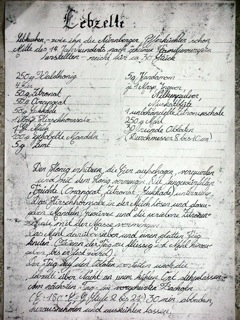Lebkuchen or Lebzelten(Honey cakes)
Lebkuchen or Lebzelte 1,2,3, as they were made by the pepper cake bakers of Nuremberg, based on a secret family recipe, used from the 14th century. - Sufficient for 30 pieces.
Ingredients:
250 g honey from forest flowers
4 eggs
50 g candied lemon peel
50 g candied orange peel
50 g Sukkade4 candied peel
1 knife tip of ammonium carbonate (today's cooks might find bicarbonate of soda easier to obtain in the shops, and it would be a viable alternative here)
1 tablespoon milk
100 g almond flakes
5 g cinnamon
5 g cardamom
1 knife tip each of ginger, ground cloves and ground nutmeg
1 lemon rind
250 g flour
30 round, thin wafers (8 - 10 cm in diameter) - of rice paper or similar
Preparation:
Cut into small cubes the candied lemon peel, orange peel and Sukkade peel. Heat the honey gently and let it cook a bit. Crack the eggs and whisk them in a bowl, then mix in first the warm honey, and then the cubes of candied peel. Dissolve the carbonate of ammonia in the milk and add this to the mixture. Then stir in the flaked almonds, spices and grated lemon rind. Sieve the flour over the mixture, mixing it in. Then knead it into a smooth dough. If too runny, add more flour. Place dough on the wafers and let the 'Lebzelten' rest overnight in a cool place. On the next day, place the Lebzelten in a preheated oven (electric: 180° C, gas: 2-3), bake for 30 minutes. Take out and allow to cool on a wire rack.
See page from old recipe book below.
Photograph (c)Wulf Schiefenhövel
Hand-written recipe by an unknown author in the recipe book of
Grete Schiefenhövel
1 handwritten recipe by an unknown author in the collection of Grete Schiefenhövel; (Fig.1)
2..Etymology: Either connected to old-high-German (h)leib (cp. English loaf, slavic chleb) originally designating unsoured bread. Lebkuchen would thus be breadcake. Or stemming from middle-Latin libum round, flat dough cake, cake, cake for sacrifices. Another etymological connection might exist to Latin libetum, labetum, designating certain types of cakes, these words could have mutated to become the German Lebzelte. - Later, the terms Lebkuchen and Lebzelte were confounded with Leben, life.
3. The translation often given in English dictionaries is 'gingerbread'; yet, only a tiny bit of ginger is used in these German recipes. In American recipe books (e.g. Rombauer 1946) recipes for 'honey cakes' are more appropriate for these lebkuchen than any recipes for gingerbread.
4. Sukkade is the candied peel of a special kind of lemon
